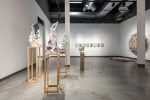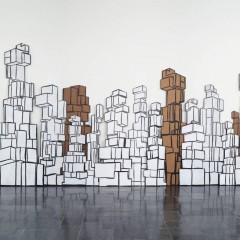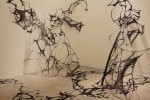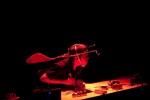Posted by Caitlin
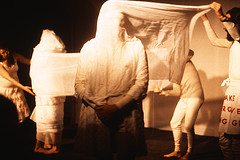
Detail of Bourgeois’ 1992 performance at the Fabric Workshop, “She Lost It”
The Louise Bourgeois exhibit at the Fabric Workshop highlights the artist’s recent works in different materials, concentrating on her use of textiles. The majority of what is on view revisits her 1992 performance “She Lost It,” which revolves around a 245 foot-long scarf with red writing.
A video documentation of the performance is on display in the lobby, with catchy dance music (you may recognize the 90’s hit “Rhythm is a Dancer”) accompanying the images of the original exhibit and the live-performance. I recommend watching the video, as it helped me to understand the importance of much of the work I was to see in the exhibit; for example, I was able to recognize the clothing worn by the performers that was displayed under glass, spread wide so that most of the writing on the front was visible. Although I do not have a better detail of these, you can make one out in the picture above: an off-white apron with the words “I had to make myself be forgiven for being a girl” in angry red stitching across the front. This article of clothing was actually worn by a man during the performance, defying the common conception of who should wear an apron, as well as asking who the “I” in the message really is – who, exactly, is the performer representing?
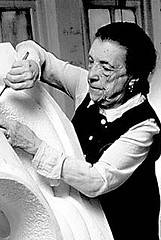
Photo of Louise Bourgeois (1999) Courtesy of Google.
Most likely, the message is from Bourgeois herself, as she considers much of her work, thematically and materially, to be autobiographical in nature. She was born in Paris in 1911 to a family involved with the tapestry industry. She later emigrated to New York in 1938, where she is currently living.
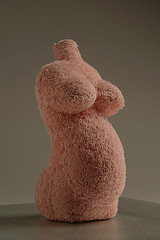
The terrycloth “Pregnant Woman” (2002) is endearing, with its soft lines and color; however, it also seems vulnerable, because of its miniature size and lack of a head. 12¾ x 12 x 12 inches
The work in the “Louise Bourgeois” exhibit is evocative and interesting, questioning the nature of relationships between people, between viewer and art, and between materials. Of notable mention were “Pregnant Woman,” a small sculpture that Bourgeois had made in 2002 for the Fabric Workshop’s 25th Anniversary, and “Couple,” a royal blue hanging sculpture of two figures wound tightly around each other in an embrace. The sculpture is free to spin, making it seem that the nature of the relationship is precarious and ungrounded, and that the couple is trying to protect it from outside forces. The fabric of which it is made is frayed at the edges, constructed without care of exterior aesthetics and almost with a hint of violence.
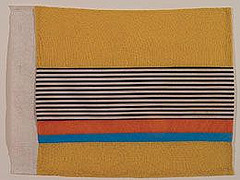
Page from Bourgeois’ book “Ode a l’Oubli”
The sculptures and artifacts from the 1992 performance in this exhibit touch on a theme that is timeless – relationships. Bourgeois highlights the many facets of relationships, and unites them into works that all viewers can understand. However, I had more trouble appreciating the book that is displayed, “Ode a l’Oubli.” It is a series of 34 hand-sewn pages printed with lithographic ink, the majority of which are abstract. There were a few with words, though, such as “I had a flashback of something that never existed,” and “The return of the repressed,” with which I felt more connected. Overall, I think that Bourgeois’ book wasn’t very successful, but that her work adorned with text and her sculptures were powerful.
For more images from Bourgeois see my flickr site here. Also, I found a video of one of her works “Cell II” at the pbs website. Although not in the show, it is similar to “Cell XX,” a piece in the show of the which I could not obtain a picture.
-Despite a long holiday, Caitlin is still the artblog intern.
“Louise Bourgeois” at the Fabric Workshop. 1315 Cherry St, 5th and 6th Floors. Monday-Friday, 10 a.m. to 6 p.m. On view until September 16, 2006.


